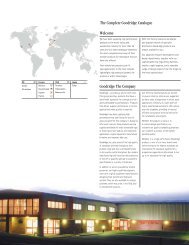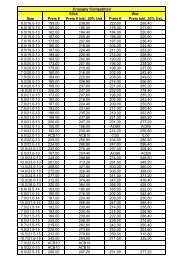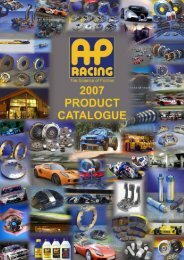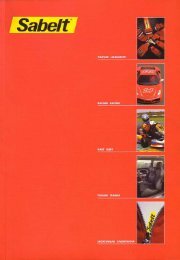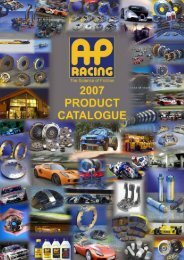Create successful ePaper yourself
Turn your PDF publications into a flip-book with our unique Google optimized e-Paper software.
84<br />
2.00<br />
8.00<br />
15.00<br />
Actuation<br />
Balance Bars<br />
CP5507-2 BALANCE BAR. CP5520-13 TRUNNION BALANCE BAR.<br />
38.50<br />
66.60<br />
91.60<br />
117.00<br />
25.00<br />
8.00 8.00<br />
26.00<br />
33.40 O/D<br />
OF HOUSING<br />
A-A<br />
35.00<br />
RUBBER<br />
BOOT<br />
49.00<br />
56.00<br />
30.00<br />
38.00<br />
15.00<br />
23.00 THREAD LENGTH<br />
5/16”x24UNF THREAD<br />
Ø12.00<br />
Ø10.00<br />
BARREL NUT<br />
SPHERICAL<br />
BEARING<br />
INTERNAL<br />
BAR<br />
WASHER<br />
EXTERNAL<br />
WASHER<br />
Ø4.00 FOR<br />
CABLE ADJUSTER<br />
AP RACING CABLE<br />
ADJUSTER CP2905-18<br />
AND STEPPER MOTOR<br />
KIT CP5500-14<br />
AVAILABLE ON<br />
REQUEST<br />
M12x1.0 THREAD<br />
1 TURN= 1.0MM OF<br />
BEARING MOVEMENT<br />
96.50<br />
BRAKE CLEVIS<br />
HOUSING GRUB SCREW<br />
BALANCE<br />
RUBBER BOOT<br />
ADJUSTER SIDE<br />
INSTALLATION.<br />
1. Position housing into a<br />
hole of required diameter<br />
(33.50) in the brake pedal.<br />
This hole should be<br />
positioned such that under<br />
normal braking loads the<br />
centre is in line with the<br />
master cylinder bores.<br />
2. Weld or bond the<br />
housing in position.<br />
3. Grease the bore of the housing and the outer race of the<br />
spherical bearing.<br />
4. Insert the balance bar with the bearing attached, into the<br />
housing with the adjuster end at the desired side.<br />
5. Insert the 2 internal washers into the housing & retain with<br />
circlips.<br />
6. Place external washers over balance bar and then screw on<br />
both clevis’s and barrel nuts until they start to bind. Then rotate<br />
one of them back one turn.<br />
Tip: Half turn adjustments can be made by taking one clevis<br />
and barrel nut back to the end of the balance bar, fl ipping the<br />
clevis over, and then threading the barrel nut back into place.<br />
7. Stretch boots over the clevis’s and locate them on the<br />
grooves on the housing and clevis’s.<br />
8. Attach adjuster to the end of the balance bar using grub<br />
screws.<br />
9. Screw in push rods and adjust so that under normal braking<br />
the balance bar lies perpendicular to the push rods and the<br />
pedal is vertical. It is not important if the balance bar is not<br />
square when released, but it should be whilst braking for<br />
maximum effi ciency.<br />
Tip: Adjustment of the push rods is made easier by running one<br />
of the two nuts supplied with each master cylinder to the end of<br />
the thread to allow the use of a spanner.<br />
2.00<br />
4 HOLES M4x0.7<br />
6.0MM FULL<br />
THREAD<br />
48.52 57.00<br />
APPLY LOAD THIS<br />
DIRECTION ONLY<br />
NB: CP5520-2 AVAILABLE WITHOUT<br />
CLEVIS ASSEMBLIES<br />
INSTALLATION.<br />
A. Fitting the Balance Bar<br />
to the Pedal<br />
1. Make 4 holes in the<br />
pedal of the recommended<br />
dimensions The centre has<br />
to be at the same height<br />
as the master cylinder centreline when pedal is square to the<br />
master cylinder.<br />
2. In positioning the balance bar on the pedal, please take<br />
notice of the direction of load, as shown. It may effect the<br />
position you choose.<br />
B. Fitting the Clevis to the Balance Bar<br />
1. Install balance bar (1) inside the central trunnion sub-assy (2).<br />
2. Push the clevis sub-assy (4) on to balance bar (1).<br />
3. Push the washer (5) against the clevis sub-assy (4)<br />
4. Push circlip (3) in to place on balance bar (1) to hold clevis<br />
sub-assy (4) in place.<br />
C. Setting up the Balance Bar<br />
1. Install remote cable and retaining screws (6).<br />
2. Install nuts provided on master cylinder pushrods.<br />
3. Adjust the pushrods so that the balance bar is perpendicular to<br />
the pushrods under maximum load. The system is then square.<br />
It is not important that the system is square when released, but<br />
it has to be under load.<br />
For maximum effi ciency, it is recommended that the pedal is at<br />
right angle with the pushrods under maximum braking load; and<br />
also keeping the balance bar central with better selection of<br />
master cylinder sizes helps to reduce ineffi ciencies. Also make<br />
sue that the master cylinder pistons fully return before use. This<br />
can be checked by feeling the pushrods for slight movements<br />
there should not be any excessive loose movement.<br />
www.apracing.com +44 (0)24 7663 9595<br />
14.00<br />
24.00<br />
51.60<br />
71.60<br />
91.60<br />
(3)<br />
CIRCLIP - CP5517-123<br />
BALANCE BAR<br />
THREAD M14x1.0<br />
12.00<br />
24.00<br />
17.00 30.00<br />
(5) SPACER -<br />
CP5517-124<br />
5/16”x24UNF EACH CLEVIS<br />
(2) CENTRAL<br />
TRUNNION<br />
SUB ASSEMBLY<br />
(4) CLEVIS<br />
SUB-ASSY<br />
20.00<br />
FULL THREAD<br />
(6) CABLE SCREW<br />
CP5500-113<br />
39.50<br />
(1) BALANCE BAR -<br />
CP5517-127



